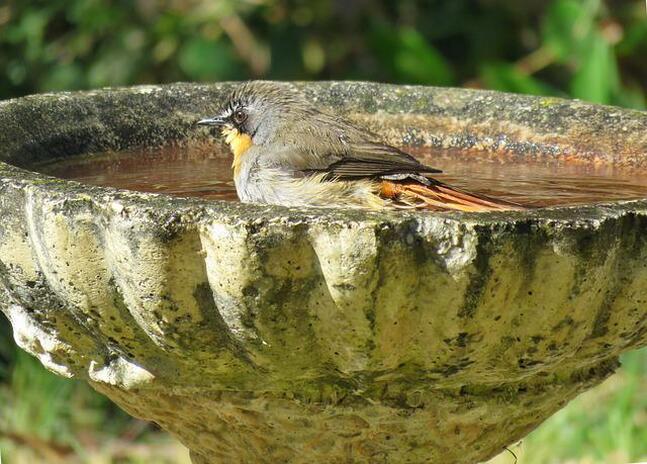Suggestions for established plants in hot weather

- Our irrigation mantra is "don't water more often, water more deeply." If you use irrigation on your garden/landscape, don't increase frequency, increase the duration of the watering cycle. You want to make sure the water goes down at least 10" to 12" into the soil. Why? Water that stays only in the top few inches of the soil will quickly evaporate, due to the drying effects of sun and wind. As mentioned above, to water thoroughly, water twice. If you water by hand, soak the plant twice (about 5 to 10 minutes apart) to make sure the soil is thoroughly saturated. If you're using a drip system, program it to come on twice, twenty minutes apart. Dry soil will often shed water the first time, leaving dry pockets that can kill tender young roots.
- Mulch! In dry heat climates (not the Gulf Coast and other regions with high humidity), shading the soil with at least an inch or two of mulch will greatly reduce soil heat, prevent evaporation of moisture from the soil, and reduce the need for increased irrigation.
- Adjust your expectations. When it's exceptionally hot and dry, it's not reasonable to expect your plants will look their best. A don't panic if plants wilt during the heat of the day. Plants wilt to conserve water. But if they don't perk up at night and the wilting becomes permanent, that's a sign that they need water. If you see permanent wilt, they may die.
- Remember, some plants go dormant in summer as a coping strategy. Most spring-blooming bulbs and some perennials may appear to die in summer, but wait before replanting their spot. They may very well re-emerge later in the summer/early fall when the temperatures drop and it starts to rain again. Oriental poppies, Prairie Skullcap and Astragalus, and many California-native herbaceous plants are examples of this response to extended hot, dry weather.
- DON'T fertilize your lawn with chemical fertilizers. If you have not converted to natural/organic lawn care and are still using these chemical salts, ignore what the instructions may say. Summer fertilization promotes thirsty hyper-growth that requires more frequent mowing, a lot more water, and will stress your turf, often leading to insect problems.
- DON'T fertilizer your trees, shrubs, or perennials with chemical fertilizers. The same is true as above, with hyper-growth that can stress the plants and require even more water.
- DO feed (fertilize) your soil organically in the fall. Top dress your landscape with compost, granular molasses, and organic fertilizers after a hard frost in fall. After a long, hot summer, the microorganisms in the soil need a boost. Healthy living soils have a much higher capacity for holding water, plus better water percolation, compared to compacted soils and those that have been damaged by prolonged use of chemical fertilizers. Granted, this is a longer-term approach, but each year you do it, the less you'll need to irrigate during the heat of summer and the more resilient your plants will be!
- In hot, humid climates, avoid planting plants with fuzzy leaves. Perennials like Lamb's Ear (Stachys) and Partridge Feather (Tanacetum) will rot above ground when their foliar fuzz is damp and hot.
- Plant late-summer and fall-blooming perennials. These will bring color back to your yard and feed hungry pollinators after the worst of the summer heat has passed. There's no reason your post-summer landscape should be without color and pollinators!
































